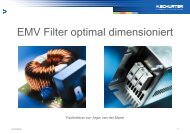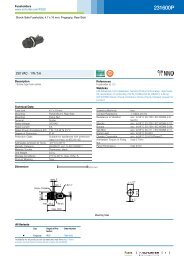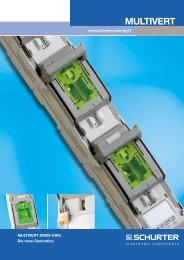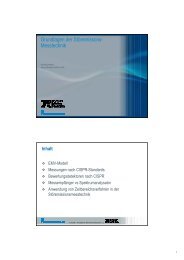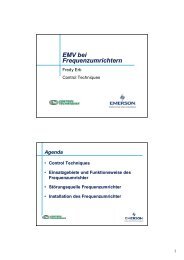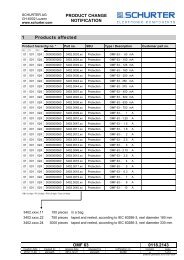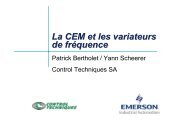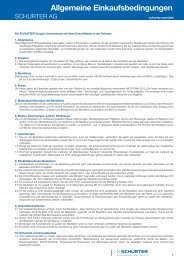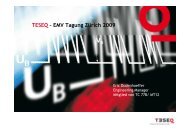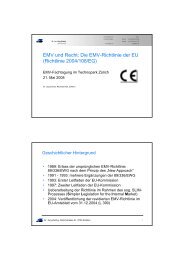Tin Whisker Testing of MSB and 172876 Fuses - Schurter
Tin Whisker Testing of MSB and 172876 Fuses - Schurter
Tin Whisker Testing of MSB and 172876 Fuses - Schurter
- No tags were found...
Create successful ePaper yourself
Turn your PDF publications into a flip-book with our unique Google optimized e-Paper software.
SCHURTER AGCH-6002 Luzernwww.schurter.comReport<strong>Tin</strong> <strong>Whisker</strong> <strong>Testing</strong> <strong>of</strong> <strong>MSB</strong> <strong>and</strong> <strong>172876</strong> <strong>Fuses</strong>INHALTSVERZEICHNIS1 INTRODUCTION ......................................................................................................................... 22 INEMI TIN WHISKER USER GROUP – TEST PROCEDURE ..................................................... 23 INEMI TESTING .......................................................................................................................... 34 ACCEPTANCE CRITERIA .......................................................................................................... 35 IMAGES....................................................................................................................................... 46 CONCLUSION............................................................................................................................. 8Page Created date: Created by: Released date: Released by: Document No. Index1 <strong>of</strong> 8 15.02.201009:43:03SKA 09.03.2010 HRÜ 0108.2693 _Druckdatum: 09.03.2010 13:32:00
SCHURTER AGCH-6002 Luzernwww.schurter.com1 IntroductionThe European Union’s directive, the Reduction on Hazardous Substances (RoHS), sets phase-out dates for theuse <strong>of</strong> lead (Pb) <strong>and</strong> several other materials used in electronic products in July 2006. The rapid transition awayfrom tin lead terminations to materials such as 100% tin has caused concern about the phenomenon <strong>of</strong> tinwhisker growth.<strong>Tin</strong> whiskers are crystalline structures that can grow from surfaces plated with pure tin. The whiskers areelectrically conductive <strong>and</strong> hence can cause concern over circuits being re-wired from r<strong>and</strong>om whisker growth.While tin whiskers are hot topics in the general electronics industry more fundamental research is required tounderst<strong>and</strong> them. Today, much mystery enshrouds tin whiskers as it is unknown what mechanisms are requiredto form a whisker <strong>and</strong> what mechanisms cause the whiskers to grow. Without such definitive answers nouniversal solution has been found to guarantee prevention <strong>of</strong> tin whisker growth. Since no solution is inexistence, tests have been designed to accelerate tin whisker growth <strong>and</strong> hence try <strong>and</strong> find electroniccomponents that are susceptible to tin whisker growth. One such test procedure is the iNEMI <strong>Tin</strong> <strong>Whisker</strong>Acceptance Test Requirements (JEDEC STANDARD JESD201 <strong>and</strong> JESD22A121.01). The mentioneddocument address the requirements for tin whisker mitigation practices <strong>and</strong> tin whisker testing necessary foruser acceptance <strong>of</strong> pure tin, or high tin content tin alloy finishes over base materials typically used in lead frametype applications.The following report details these tests as were performed on the <strong>MSB</strong> <strong>and</strong> <strong>172876</strong> fuses which uses pure tinover nickel plated base material.2 iNEMI <strong>Tin</strong> <strong>Whisker</strong> User Group – Test procedureThe following table shows the tests performed on the <strong>MSB</strong> <strong>and</strong> <strong>172876</strong> in order to accelerate the growth <strong>of</strong> tinwhiskers. These test conditions represent a minimum set <strong>of</strong> conditions that shall be used to assess thepropensity for tin whisker growth on any given tin finish under study:FlowThermal CyclingAmbient Temperature /Humidity storageHigh Temperature/HumiditystorageTest Condition1’500 cycles, 3 cycles/hr, Min Temp -55 to -40 (+0/-10 )°C, Max Temp+85 (+10/-0 )°C, air to air; 5 to 10 minutes soak, Inspection intervals500cycles/1000cycles/1500cycles4’000 hrs @ 30±2°C <strong>and</strong> 60±3% RH, Inspection intervals1000hrs/2000hrs/3000hrs/4000hrs4’000 hrs @ 60±5°C <strong>and</strong> 87+3/-2% RH, Inspection intervals1000hrs/2000hrs/3000hrs/4000hrsPreconditioning was used before each test. The preconditioning details were as follows:ItemDetailsPreconditioningStorage at room temperature for 4 weeksAssembly SnPb Solder reflowed at 215°CAssembly Pb-free Solder reflowed at 255°COnce the samples were tested to the above procedure, they were inspected using an optical microscope LeicaMZ 16A capable <strong>of</strong> detecting whiskers with a minimum axial length <strong>of</strong> 10 microns.Page Created date: Created by: Released date: Released by: Document No. Index2 <strong>of</strong> 8 15.02.201009:43:03SKA 09.03.2010 HRÜ 0108.2693 _Druckdatum: 09.03.2010 13:32:00
SCHURTER AGCH-6002 Luzernwww.schurter.com3 iNEMI <strong>Testing</strong>The inspection areas for tin whisker growth <strong>of</strong> the <strong>MSB</strong> <strong>and</strong> <strong>172876</strong> fuses are outlined below.<strong>Tin</strong> SurfaceTypematte Snover Cu <strong>and</strong>brassType<strong>MSB</strong><strong>172876</strong>aefbgcdh4 Acceptance CriteriaPage Created date: Created by: Released date: Released by: Document No. Index3 <strong>of</strong> 8 15.02.201009:43:03SKA 09.03.2010 HRÜ 0108.2693 _Druckdatum: 09.03.2010 13:32:00
SCHURTER AGCH-6002 Luzernwww.schurter.comTest resultsThe following tables outline the results <strong>of</strong> tin whisker growth on the samples after the threetesting conditions.<strong>Tin</strong> <strong>Whisker</strong> Inspection after Temperature CyclingPart number Preinspection500TemperatureCycling1000TemperatureCycling2000Temperature.Cycling<strong>MSB</strong>, <strong>172876</strong> No <strong>Whisker</strong> No <strong>Whisker</strong> No <strong>Whisker</strong> No <strong>Whisker</strong><strong>Tin</strong> <strong>Whisker</strong> Inspection after Ambient Temperature Humidity StoragePart numberAmbientTemp/HumidityStorage1000hrsAmbientTemp/HumidityStorage2000hrsAmbientTemp/HumidityStorage3000hrsAmbientTemp/HumidityStorage4000hrs<strong>MSB</strong>, <strong>172876</strong> No <strong>Whisker</strong> No <strong>Whisker</strong> No <strong>Whisker</strong> No <strong>Whisker</strong><strong>Tin</strong> <strong>Whisker</strong> Inspection after High Temperature Humidity StoragePart number<strong>MSB</strong>,<strong>172876</strong>HighTemp/HumidityStorage 1000hrs<strong>Whisker</strong>detectedAreaWheredetectedNo<strong>Whisker</strong> -HighTemp/HumidityStorage 2000hrs<strong>Whisker</strong>detectedAreaWheredetectedNo<strong>Whisker</strong> -HighTemp/HumidityStorage 3000hrs<strong>Whisker</strong>detectedAreaWheredetectedNo<strong>Whisker</strong> -HighTemp/HumidityStorage 4000hrs<strong>Whisker</strong>detectedAreaWheredetectedNo<strong>Whisker</strong> -5 Images**New State**Picture 1: <strong>MSB</strong>, <strong>172876</strong> (section b) Picture 2: <strong>MSB</strong>, <strong>172876</strong> (section d)Page Created date: Created by: Released date: Released by: Document No. Index4 <strong>of</strong> 8 15.02.201009:43:03SKA 09.03.2010 HRÜ 0108.2693 _Druckdatum: 09.03.2010 13:32:00
SCHURTER AGCH-6002 Luzernwww.schurter.comNo Preconditioning**After 1500 Temperature Cycling Test**Picture <strong>MSB</strong>, <strong>172876</strong> (section a) Picture 2: <strong>MSB</strong>, <strong>172876</strong>, (section b)Precondition: Sn/Pb Solder reflowed at 215°CPicture 3: <strong>MSB</strong>, <strong>172876</strong> (section d) Picture 4: <strong>MSB</strong>, <strong>172876</strong> (section e)Precondition: Pb-free Solder reflowed at 255°CPicture 5: <strong>MSB</strong>, <strong>172876</strong> (section c) Picture 6: <strong>MSB</strong>, <strong>172876</strong> (section f)Page Created date: Created by: Released date: Released by: Document No. Index5 <strong>of</strong> 8 15.02.201009:43:03SKA 09.03.2010 HRÜ 0108.2693 _Druckdatum: 09.03.2010 13:32:00
SCHURTER AGCH-6002 Luzernwww.schurter.comNo Precondition** After 4000hrs Ambient Temperature Humidity Storage**Picture 7: <strong>MSB</strong>, <strong>172876</strong> (section c) Picture 8: <strong>MSB</strong>,<strong>172876</strong> (section h)Precondition: Sn/Pb Solder reflowed at 215°CPicture 9: <strong>MSB</strong>, <strong>172876</strong> (section d) Picture 10: <strong>MSB</strong>, <strong>172876</strong> (section e)Precondition: Pb-free Solder reflowed at 255°CPicture 11: <strong>MSB</strong>, <strong>172876</strong> (section a) Picture 12: <strong>MSB</strong>, <strong>172876</strong> (section b)Page Created date: Created by: Released date: Released by: Document No. Index6 <strong>of</strong> 8 15.02.201009:43:03SKA 09.03.2010 HRÜ 0108.2693 _Druckdatum: 09.03.2010 13:32:00
SCHURTER AGCH-6002 Luzernwww.schurter.com**After 4000hrs High Temperature Humidity Storage Test**No PreconditionPicture 13: <strong>MSB</strong>, <strong>172876</strong> (section b) Picture 14: <strong>MSB</strong>, <strong>172876</strong> (section b)Precondition: Sn/Pb Solder reflowed at 215°CPicture 15: <strong>MSB</strong>, <strong>172876</strong> (section b) Picture 16: <strong>MSB</strong>, <strong>172876</strong> (section b)Precondition: Pb-free Solder reflowed at 255°CPicture 17: <strong>MSB</strong>, <strong>172876</strong> (section f) Picture 18: <strong>MSB</strong>, <strong>172876</strong> (section g)Page Created date: Created by: Released date: Released by: Document No. Index7 <strong>of</strong> 8 15.02.201009:43:03SKA 09.03.2010 HRÜ 0108.2693 _Druckdatum: 09.03.2010 13:32:00
SCHURTER AGCH-6002 Luzernwww.schurter.com6 ConclusionThe tests where performed on a total number <strong>of</strong> 81 pieces <strong>MSB</strong>, <strong>172876</strong>. We could not find anywhisker growth over 40µm during <strong>and</strong> at the end <strong>of</strong> the three test conditions.9.02.2010 Peter Straub, Manager Circuit ProtectionPage Created date: Created by: Released date: Released by: Document No. Index8 <strong>of</strong> 8 15.02.201009:43:03SKA 09.03.2010 HRÜ 0108.2693 _Druckdatum: 09.03.2010 13:32:00



